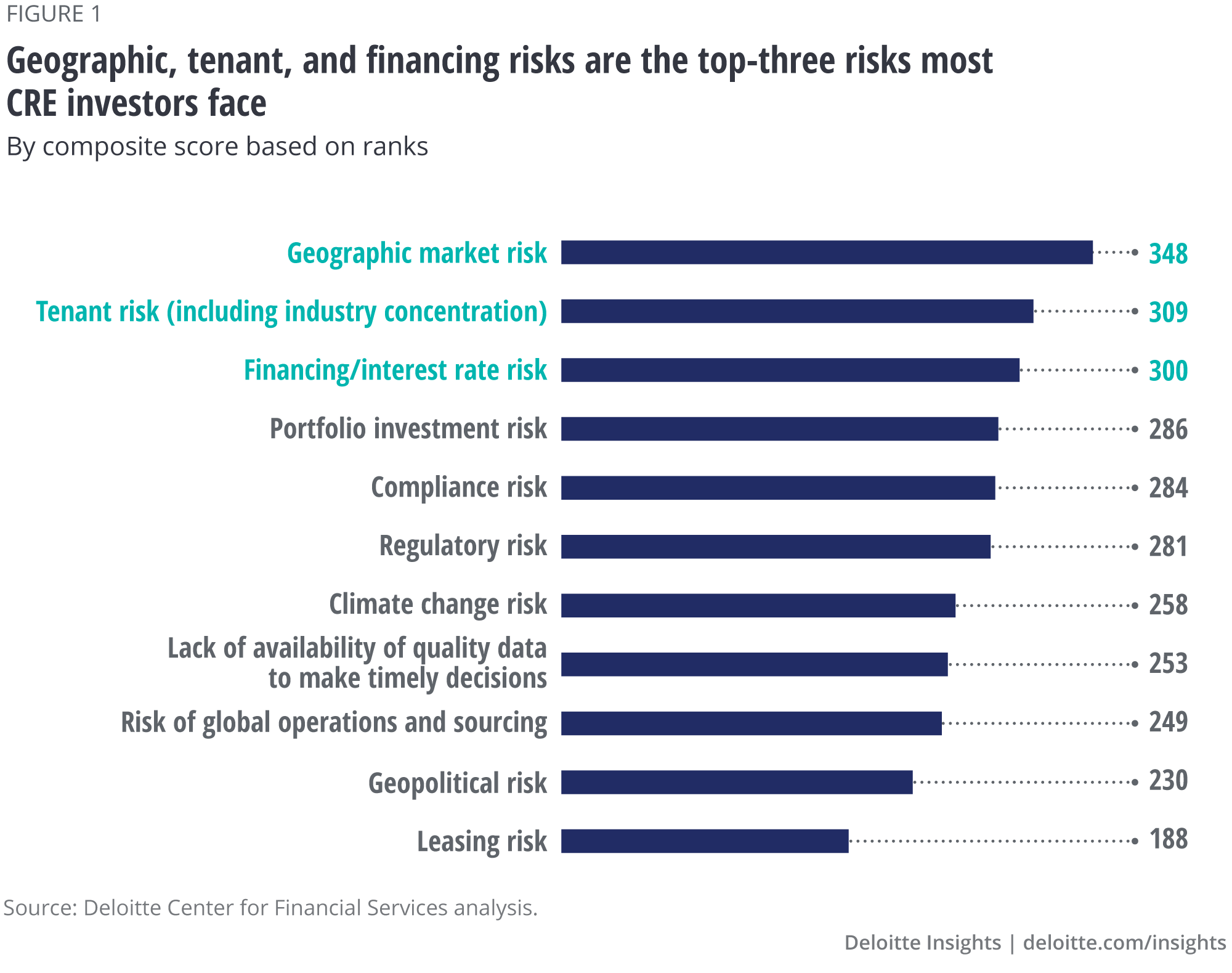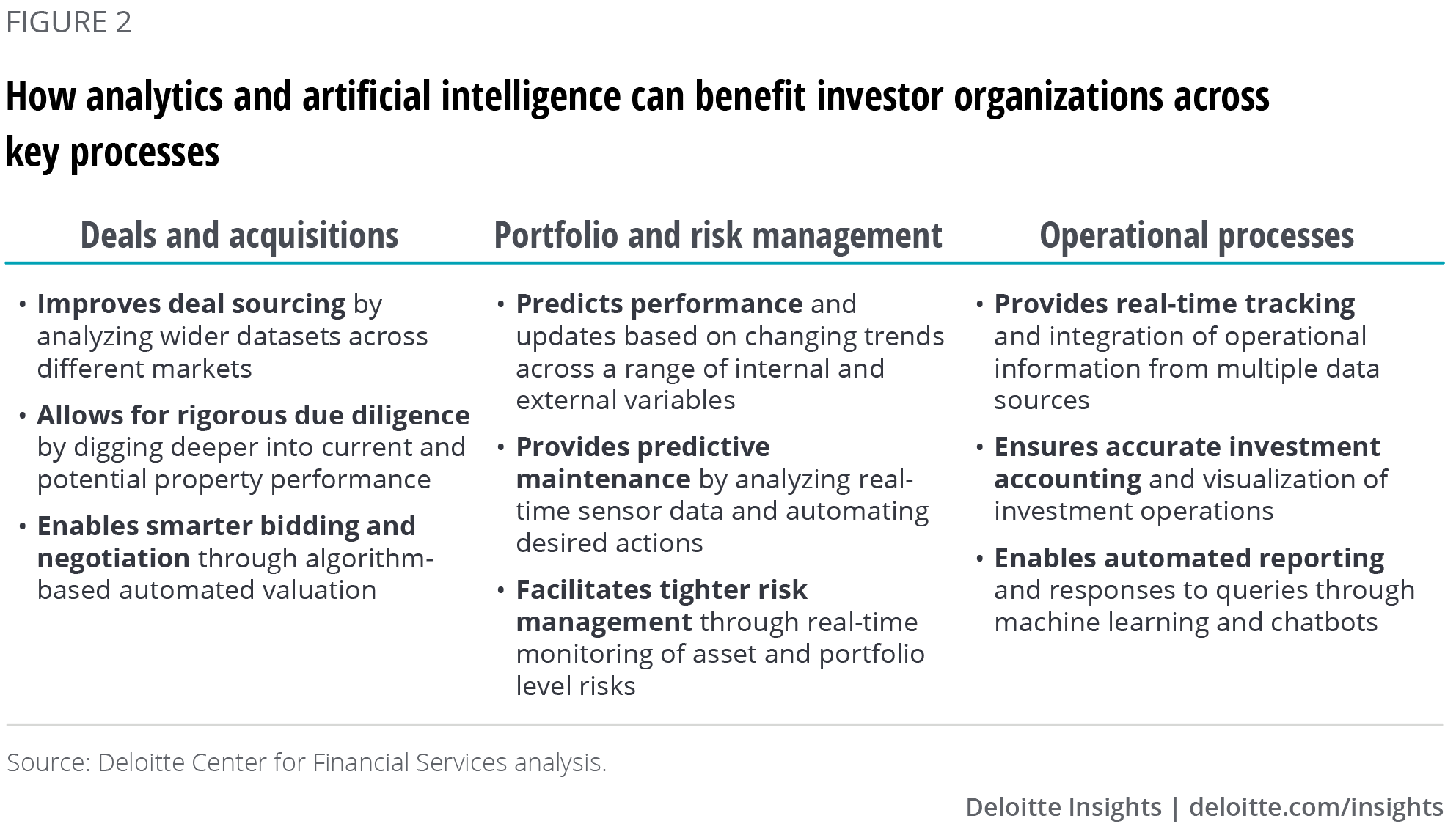
Infusing data analytics and AI The future of smart decision-making for real estate institutional investors and managers
9 minute read
18 June 2019
The commercial real estate market has lagged behind other financial sectors in fully embracing data analytics capabilities. Learn why now may be an opportune time to change that.
Real estate institutional investors face a challenging environment
Several factors appear to be limiting growth and profitability for real estate institutional investors. Faced with higher risks and competition, commercial real estate (CRE) investors posted negative average annual returns in 2018, both globally (-5.6 percent) and in the United States (-4.1 percent).1 In comparison, average annual returns were 6.4 percent and 6.9 percent globally and in the United States, respectively, during the 2014 –2017 period.2 Deloitte’s 2018 Global Real Estate Institutional Investor survey of 500 global institutional investors seems to show respondents remain committed to CRE as an asset class: 97 percent of the respondents plan to increase their capital commitment through 2019. However, their investment decisions are likely to be challenged by geographic market, tenant, and financing/interest rate risks (see figure 1). There are also growing headwinds around the 2020 US presidential elections, the potential threat of trade tariffs, a flattening yield curve, and a global economic slowdown. To respond to these possible challenges, investors are seeking new ways to improve efficiency and effectiveness.

Learn more
Explore the Financial services collection
Visit the Analytics collection
Subscribe to receive related content
Investors and investment managers can use data analytics and artificial intelligence (AI) in their existing acquisition, disposition, and portfolio management processes to manage rising risks and complexities more effectively and mitigate fees and margin pressure. There is much more data available today than there was even just a few years ago. Information such as net effective rents, leasing spreads, lease comps, market demand, and tenant information have now become much more accessible and granular.3 In addition, alternative datasets from IoT sensors, social media, geospatial information, and satellite imagery are increasingly being used. And new forms of analytics solutions, backed by AI, can help investment managers harness this broader range of data to make more informed decisions faster and more accurately.
What’s stopping investor firms from adopting data analytics?
To date, most CRE managers and investors continue to make heuristic, or instinct-based, decisions rather than informed ones. Why? Perhaps, many are unaware of the wide variety of datasets, lack the analytical capabilities to generate insights, and/or are resistant to change. Some may be unsure where to start; others may not know which new skills and capabilities should be added to begin. Here are some of the key barriers:
Lack of awareness about new datasets and analytical techniques. Traditionally, sourcing consistent and accurate property- and market-related data has been a difficult task. There are no commonly accepted and widely adopted industry standards around data definitions and governance. As such, data gathering, analysis, and reporting is at a surface level and requires substantial human effort, which often results in information silos and leaves limited time to analyze information on a more granular level. Managers could spend as much as 80 percent of their time on gathering or manipulating data to make it ready for analysis.4 These current process inefficiencies prevent some institutional investors and managers from exploring new sources of data and in-depth analytical tools and capabilities.5
Limited analytical capabilities. Investors and managers have limited capabilities when it comes to sourcing, aggregating, and analyzing huge datasets from multiple sources.6 They need appropriate talent, tools, and technology to effectively leverage data analytics to make investment decisions and comply with more rigorous reporting and risk management requirements.
Data risks and uncertainty of return on investment (ROI). New technologies come with their own risks. While the new datasets have merit, there are several inherent risks, perhaps more than using traditional data. Investors and managers would have to do due diligence to verify the authenticity of the origin of the data.7 There could be privacy risks if the sourced data includes personally identifiable information or material nonpublic information.8 If there is a lack of transparency about the data collection method, there will likely be concerns around its accuracy and validity.9 Finally, investor organizations may not be confident about the ROI of using alternative data.
Limitations of a heuristic mindset. The industry has long thrived on relationships, which is how many investors have traditionally gained access to unique information. Traditionally, most investors have combined this information with their gut instincts to make investment decisions. However, with increased availability and transparency of data, access to information may not be a competitive advantage anymore. There will likely be more blind spots as institutional investors seek innovative approaches to diversify their portfolios. For instance, some of the newer business models, such as short-term rentals for cosharing spaces, have different dynamics and a limited track record of performance and returns. For investors and managers evaluating these new business models, relying on intuition may not be enough. Use of data analytics would reduce subjectivity as they continue to follow the traditional decision-making approach.
Embracing data analytics and AI: Key benefits
Adopting data analytics and AI into existing processes can be particularly valuable during slower business environments. CRE data has improved over the last few years; it is now easier to track buildings across several markets more meticulously. Technologies such as AI and machine learning can use this data to improve efficiency by identifying patterns and opportunities, predicting future scenarios, and even automating certain tasks.
Investors and managers can leverage analytics and AI across key steps in the investment life cycle, from deal sourcing to portfolio management to risk management. In addition, these technologies can help increase efficiency and effectiveness of operational processes, such as information integration, investment accounting, and reporting (see figure 2). For instance, during due diligence, investors can use diagnostic analytics to understand the correlations between property performance and user movement within and around the property, weather conditions, and energy prices.
For portfolio management, investor organizations can use predictive analytics to forecast performance based on a wide range of traditional and alternative datasets. For instance, retail mall investors can use traditional property data around performance, combine it with alternative retail sales data from mobile sensors, social media, and physical store sales, and use machine learning algorithms to analyze consumer buying behavior for a geography or to profile retail tenants.
Advanced analytics can help investors and managers better understand the sources of risk—from asset level, to macroeconomic, to regulatory—so they can draft appropriate mitigation measures. For a diversified CRE portfolio, this could involve assessing risk and return across multiple property types, geographies, and regulators. Investors and managers can use analytics solutions to help decode the historical relationships between different variables across several market cycles and forecast potential portfolio risks.
The use of alternative and traditional datasets and the application of advanced analytics can help reduce human bias through more objective decision-making. It can result in faster decision-making, lower transaction and operational costs, and more rigorous risk management and portfolio optimization. Some of the data analytics-driven information repositories, insights, and efficiencies could allow institutional investor firms to uncover untapped value in their current and potential CRE investments.

GeoPhy: Powering efficient and effective decision making:10
Netherlands-based proptech GeoPhy gathers and links more than 3,000 traditional and new real estate variables for nearly 100 million buildings. Its data lake includes economic, demographic, and property-related characteristics such as size, age, tenants, liens, and last-traded price along with location-related information such as density of catchment areas, nearby retail and entertainment properties, and crime rates. Its GeoPhy REACH technology tracks geospatial information for each property, which can enable more informed acquisition decisions.
GeoPhy uses machine learning–based automated valuation models to calculate real-time valuations that dynamically update with every new data point. It provides details about the drivers behind the valuations, which are intended to make the data transparent. Compared to the existing sources, the proptech aims to provide a solution that improves information availability, consistency, scalability, and quality while reducing potential for human bias.
GeoPhy’s data and automated valuation models can be used for due diligence, site selection, and deal negotiation. Institutional investors and mangers can manage and benchmark their portfolio using unconventional parameters such as sustainability or a property’s health to assess quality and risk.
Getting started with alternative data and analytics
Although most institutional investors and managers are just beginning to use alternative data and advanced analytics, these tools are expected to become imperative to the future investment landscape. So, how can CRE investors and managers get started or do more with alternative data and analytics? They should consider focusing on two main goals: Developing a data management plan and changing the organizational mindset to embrace more objective and data-backed decisions.
Developing a data management plan
In the beginning, the myriad datasets and analytics tools can be intimidating. Investors and managers should work together to develop a plan that includes key areas of data analytics implementation, appropriate data sources and tools, and required skill sets. Essentially, for using advanced analytics and AI, CRE investors and managers must first build a data foundation. This typically involves establishing data standards, eliminating enterprise data siloes, and establishing data governance protocols.
Investors and managers should first assess existing processes to identify areas in which they are lagging and those in which data analytics and AI would likely most benefit them. For instance, some investors may need data analytics to improve their deal sourcing and bidding capabilities, while others may use it to help generate smarter portfolio management options. Second, investors and managers should better understand the different types of datasets and analytics solutions currently available. They should ensure these tools are compatible with the existing architecture and conduct due diligence of data sources in terms of quality and potential privacy risks. Third, investor firms should identify the skill sets they expect to use for advanced analytics. Their investment teams would need to have the right combination of data analytics skill sets and industry experience. Having a combination of traditional and alternative data sources can help firms produce unique and relevant insights and enable smarter decision-making.
Still, investors and managers should do a cost-benefit analysis to determine if they should develop in-house databases and data analytics capabilities versus outsourcing these efforts to third-party vendors or proptechs, or a mix of both.
There’s nothing mysterious about developing a data management plan. It can start tomorrow; it just needs organization and discipline.
Embracing a data-driven mindset
Adopting a new approach and changing behavior throughout an organization is not easy. C-suite leaders will need to clearly articulate the benefits of utilizing alternate datasets and analytics. They should act as change champions, taking ownership and being accountable for setting a data-driven culture. Communications should focus on the vision, strategy, and benefits of data-backed decision-making. And, for organizations that don’t yet have one, adding a chief data officer or equivalent to the C-suite would signal how seriously the organization is taking this effort.
While C-suite leaders need to understand how much change is required and strategize the data analytics journey of the firm, they needn’t do this alone. They can and should delegate some of the accountability to middle management. Instilling a more data-driven mindset among employees could require employees to think and behave differently. Leaders may want to offer incentives to employees who embrace these changes most effectively. The focus should be more on exploring new possibilities, not on data procurement and management tasks that can be automated. However it’s done, success depends on fundamentally believing that data is an important enterprise asset and should be treated as such.
New roads, new rules
Institutional investors are known for identifying investment opportunities that generate higher alpha. Even now, they are razor focused on evaluating new investment opportunities to diversify their portfolio. This is largely due to a challenging deal-making environment amid macroeconomic headwinds.
Some of the new RE business models such as flexible leases or spaces are evolving. Many investors and managers lack prior experience in making investment decisions for such properties. Investors and managers should recognize that the technology advancements are moving at a fast pace, perhaps faster than their speed of decision-making. As such, using alternative datasets and advanced analytics would enable them to make more informed decisions and could increase their efficiency and effectiveness. There tends to be noise around loss of human touch or even jobs with increased use of analytics, especially AI, in decision-making. Contrary to this belief, the intent is to carve out time for employees to think, innovate, use more in-depth insights to augment decision-making.
© 2021. See Terms of Use for more information.
Explore the Financial services collection
-
The future of the industrial real estate market Article5 years ago
-
Reimagining customer privacy for the digital age Article5 years ago
-
The value of online banking channels in a mobile-centric world Article6 years ago
-
Reshaping the cybersecurity landscape Article4 years ago
-
Bringing digital to the boardroom Article6 years ago












